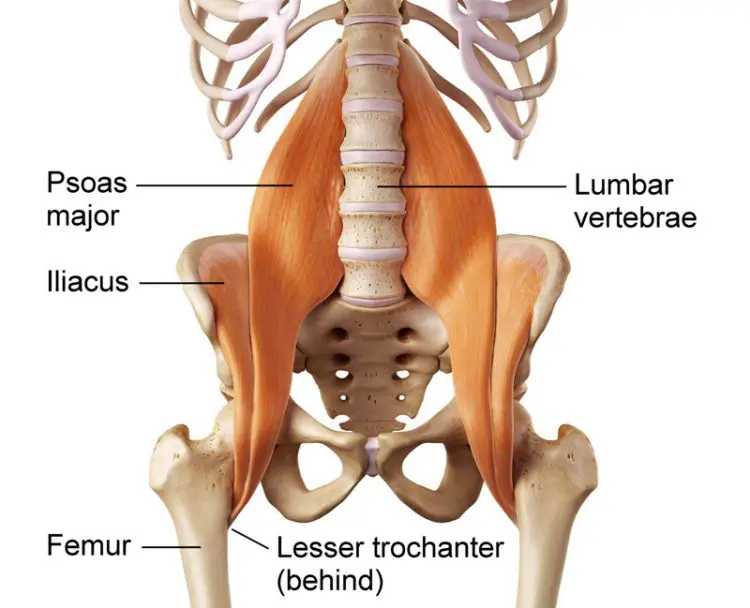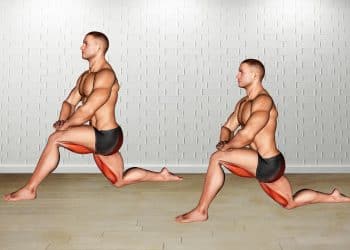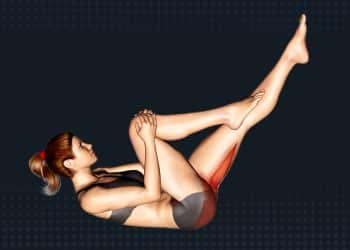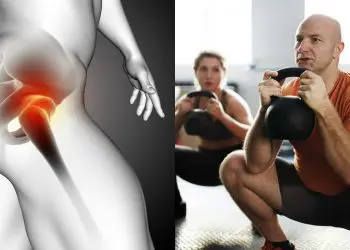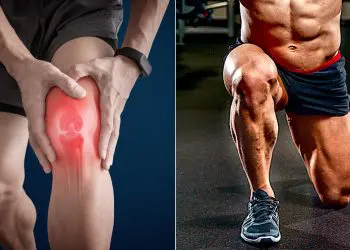Your body is amazing! It’s made up of 206 bones, over 600 named muscles, dozens of organs and systems, and literally miles of nerves and blood vessels. When everything is working as it should, the human body can perform phenomenal feats of strength and endurance.
But all it takes is one weak or overly tight muscle to stop the “human machine” from working correctly. Even a small muscle can cause serious problems.
Of all the muscles of your body, the psoas is one of the most important. Keeping this muscle strong and flexible will enhance your athletic performance and help prevent a whole lot of hip and lower back pain.
In this article, we discuss the functional anatomy of the psoas muscle and reveal the best exercises for strengthening and stretching it.
Psoas Anatomy
The psoas (pronounced so-as – the p is silent) is a long fusiform muscle that connects your lumbar spine to your femur or thigh bone. Fusiform means the fibers run parallel to the length of the muscle.
Level Up Your Fitness: Join our 💪 strong community in Fitness Volt Newsletter. Get daily inspiration, expert-backed workouts, nutrition tips, the latest in strength sports, and the support you need to reach your goals. Subscribe for free!
There are three muscles that make up and work with the psoas: psoas major, psoas minor, and the iliacus. Subsequently, these muscles are often collectively known as the iliopsoas because they typically work together.
Most people refer to these muscles as the hip flexors, and the psoas is the largest and strongest muscle within this group.
The psoas is a biarticular muscle, which means it crosses two joints and, as such, has several functions. The primary actions of the psoas are:
- Hip joint flexion
- External hip rotation
- Adduction of the hip joint
- Core and hips stability
Because the psoas essentially bridges the gap between your torso and your lower body, it’s a critical muscle in many movements. It’s also prone to tightness, as sitting places it in a shortened position. Too much sitting and not enough stretching can adversely affect the health of your psoas.
A tight psoas muscle can cause numerous issues, including:
- Hip pain
- Groin pain
- Abdominal pain
- Knee pain
- Ankle pain
- Neck pain
- Lower back pain
Weak psoas can also cause problems, as it could lead to hip and lower back instability. When the psoas is weak, other muscles will have to step in to do the work your psoas is not. This can cause pain and hip and lower back instability.
How can one muscle cause so many issues? If it’s weak or tight and short, the psoas will affect the movement and alignment of your lumbar spine and hips, which will have a knock-on effect on all the joints and structures above and below. That’s why your psoas is such an important muscle.
The good news is that stretching and strengthening your psoas is relatively straightforward.
How to Test for Weak Psoas
Psoas weakness is relatively rare. That’s because the psoas is involved in most core exercises and is very active when you walk or run. That said, a weak psoas can happen, so it’s worth knowing how to identify and strengthen it.
Do the following test to see if your psoas is weak:
- Stand with your feet together and your arms by your sides.
- Bend one leg and lift your thigh up so that it’s parallel to the floor.
- Hold this position for as long as you can, making a mental note of what happens and how you feel.
- Repeat the test on the opposite side and compare results.
If you cannot hold your leg up for 30 seconds or more or feel your lower back arching, you may have weak psoas, and it probably needs strengthening.
Psoas Strengthening Exercises
If you did the test outlined above, you should now know if your psoas is weak. If you felt your lower back arching or you failed to hold your leg up for 30 seconds or more, you need to spend some time strengthening your psoas muscle.
The good news is that training the psoas is a straightforward process, and you can do most of the following strengthening exercises at home and with minimal training equipment
Choose 2-3 of these exercises and do a couple of sets of each one every other day until you can comfortably pass the psoas strength test. Maintain psoas strength by doing a psoas exercise or two once or twice a week after that.
1. Isometric supine unilateral leg lifts
Your muscles are stronger isometrically (statically) than they are dynamically. This exercise is ideal for strengthening a very weak psoas. It’s simple to perform, and you can easily do a few sets while sitting at home watching TV.
How to do it:
- Lie on your back on the floor. Brace your core. Support your head with a cushion.
- Keeping your upper body relaxed, lift one leg 18-24 inches off the floor. Keep it straight.
- Hold this position for as long as comfortable.
- Lower your leg to the floor and then switch sides.
2. Supine unilateral leg lifts
Once you have built some basic strength using isometrics, it’s time to progress to a more dynamic exercise. This is basically a moving version of exercise #1.
How to do it:
- Lie on your back on the floor. Brace your core.
- Keeping your upper body relaxed, lift one leg until it’s just less than perpendicular to the floor.
- Lower it back down and repeat until your muscles begin to fatigue.
- Switch legs and repeat.
- You can also do this exercise using an alternating leg action.
3. Captain’s chair bent knee raise
Usually thought of as a abs and core exercise, the captain’s chair bent knee raise is also an effective psoas exercise. Most gyms have a captain’s chair.
Level Up Your Fitness: Join our 💪 strong community in Fitness Volt Newsletter. Get daily inspiration, expert-backed workouts, nutrition tips, the latest in strength sports, and the support you need to reach your goals. Subscribe for free!
How to do it:
- Put your back against the backrest and support your weight on your elbows. Hold yourself in position by gripping the handles. Let your legs hang straight down, feet clear of the floor.
- Bend your legs and pull your knees up in front of you. Your thighs should be at least parallel to the floor.
- Lower your legs and repeat.
- Take care to lift and not swing your legs up. Momentum will take tension off the target muscles.
4. Hanging bent knee raise
No captain’s chair? No problem! You can also do hanging knee raises from a pull-up bar. This exercise will also strengthen your grip and decompress your spine.
How to do it:
- Grip and hold an overhead bar with an overhand, shoulder-width grip. Hang with your arms and legs straight, feet clear of the floor.
- Bend your legs and pull your knees up in front of you. Your thighs should be at least parallel to the floor.
- Lower your legs and repeat.
- Take care to lift and not swing your legs up. Momentum will take tension off the target muscles.
- Make this exercise harder by keeping your legs straight.
5. Boat pose
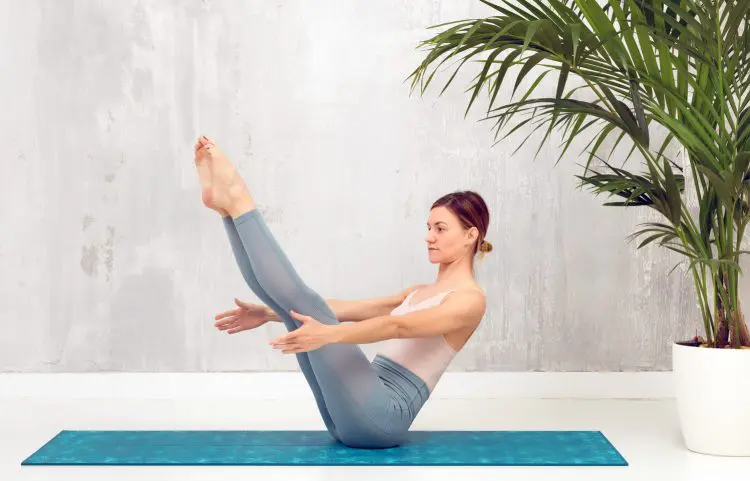
Boat pose is a yoga exercise that will strengthen your core and psoas at the same time. It’s also good for your balance and flexibility. This is a useful exercise if you don’t have a captain’s chair or pull-up bar. Like exercise #1, the boat pose is an isometric exercise.
How to do it:
- Sit on the floor with your legs bent and feet flat. Sit up and place your hands on the side of your knees. Your arms should be parallel to the floor. Brace your core.
- Extend your legs and lift your feet off the floor so you are balancing on your butt and your body resembles a V shape.
- Hold this position for as long as you can.
- Too tough? You can also do this exercise with your knees bent or while holding the backs of your knees for extra support. However, you should progress to an unsupported boat pose as soon as you are able.
6. Standing psoas band march
This exercise dynamically strengthens your psoas and replicates how this muscle works when you walk and run. The standing psoas band march is an excellent warm-up exercise as it also mobilizes your hip joints.
How to do it:
- Place a mini-band around your feet and stand about arms’ length from a wall or pillar. Place your hands against the wall for balance. Brace your abs.
- Bend one leg and lift your knee up to about hip height.
- Lower your leg and switch sides.
- Continue alternating sides until you feel your muscles starting to fatigue.
7. Single leg plank
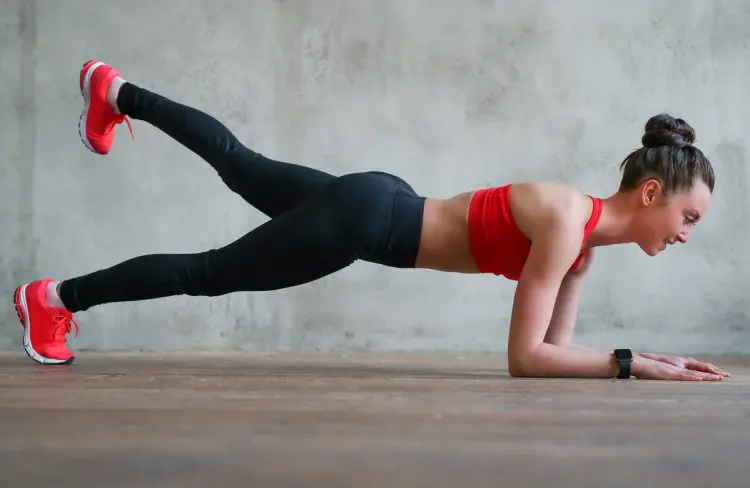
Planks are a popular core exercise and, when done with just one leg on the floor, turns into an effective psoas exercise.
How to do it:
- Lie on your front and rest on your elbows and forearms.
- Lift your hips off the floor, so your body is straight. Brace your core.
- Raise one leg and support your weight on your forearms and one foot only.
- Hold for as long as possible and then switch sides.
8. Psoas bridge march
This exercise is a great twofer. As well as strengthening your psoas, it fires up and strengthens your glutes too. Do it as a psoas builder or before squats and deadlifts to activate your hips and boost workout performance.
How to do it:
- Put a mini-band around your feet and lie on your back. Place your feet on an exercise bench. Lift your hips off the floor, so your body is straight. Brace your abs.
- Bend one leg and pull your knee in toward your chest.
- Swap legs and repeat.
- Keep your hips up, and your core braced throughout.
How to Test for Tight Psoas
Psoas tightness is a common problem. When you sit, your psoas is placed in a flexed and shortened position. Your muscles gradually adapt to this position and tighten up in response. Tight psoas will reduce your range of motion, preventing full hip extension. It will also pull on your lumbar spine, increasing the risk of back pain.
If you have an excessive lumbar curve (hyperlordosis), there is a very good chance that tight psoas is the reason.
Check if your psoas is tight by performing the following test:
- Sit on the edge of a table or massage couch.
- Bend one leg and hold your knee. Pull your knee into your chest.
- Lie back on the table.
- If your opposite leg hangs down below the level of the table, your psoas is probably flexible enough.
- However, if your knee is level or higher than your hip, your psoas is short and tight.
- Do this test on both sides to see if there is a difference between your left and right psoas.
Psoas Stretching Exercises
If you failed the psoas flexibility test, you need to start stretching this critical muscle. Stretch your psoas daily, and especially after long periods of sitting. Take care to ease into each stretch, and only stretch deeper when you feel your muscles relax. Do not force any of the following stretches; overstretching can cause serious injury.
1. Kneeling lunge
You can do this straightforward exercise almost anywhere and anytime. If your psoas is especially tight, try doing this stretch every hour or so to break up long periods of sitting; your hips and lower back will thank you for it.
How to do it:
- Step forward and bend your legs. Place your rear knee on the floor. Your front shin should be vertical.
- Gently push your hips forward to stretch the hip flexor on your rearmost leg.
- Take care not to hyperextend your spine. Instead, keep your lumbar spine and pelvis neutral.
- Hold for 30-60 seconds and then switch sides.
2. Half-kneeling quadriceps and psoas stretch
A tight psoas is often accompanied by tight quadriceps. The rectus femoris works with psoas to flex your hips. This stretch hits both of these important muscles.
How to do it:
- Step forward and bend your legs. Place your rear knee on the floor. Your front shin should be vertical.
- Reach back and pull your rear foot in toward your butt.
- Gently push your hips forward to stretch the hip flexor and quad on your rearmost leg.
- Take care not to hyperextend your spine. Instead, keep your lumbar spine and pelvis neutral.
- Hold for 30-60 seconds and then switch sides.
3. Couch stretch
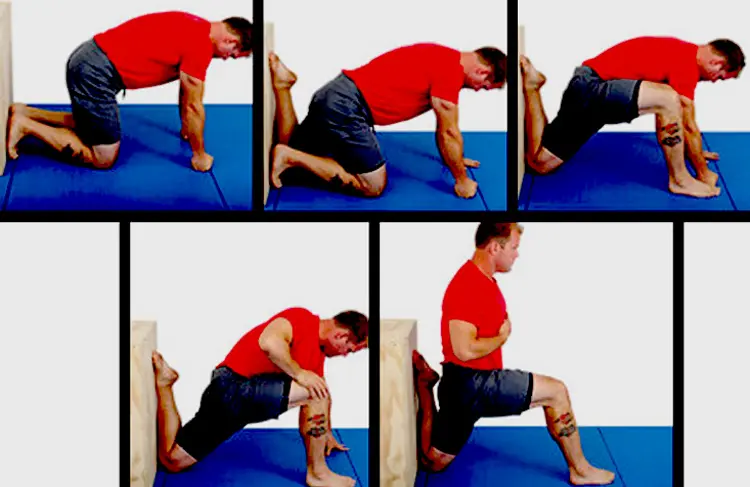
If you’ve loosened up your psoas, you are probably ready for a more intense hip flexor stretch. The couch stretch works your psoas, quads, and hips in general. This stretch isn’t easy, but it could be the best thing you can do for your hips.
Check out our in-depth guide to the couch stretch to find out how to do this exercise. The article also includes some progressions and alternatives.
Best Psoas Exercises and Psoas Stretches – Wrapping Up
You might not be able to see your psoas, but that doesn’t mean it’s not an important muscle. In fact, despite being out of sight (and out of mind), if it’s tight, weak, or both, the psoas can cause a whole lot of problems.
Don’t ignore your psoas; it could be your undoing! Instead, test for weakness and tightness, and then fix whatever problems you find.
Tight psoas is a widespread problem, usually caused by too much sitting. Weak psoas is not as common, but it can still be an issue for some people.
The good news is that tight and weak psoas muscles are relatively easy to address, and you can do most of the stretching and strengthening exercises in this article at home. All you need is a few minutes per day.

